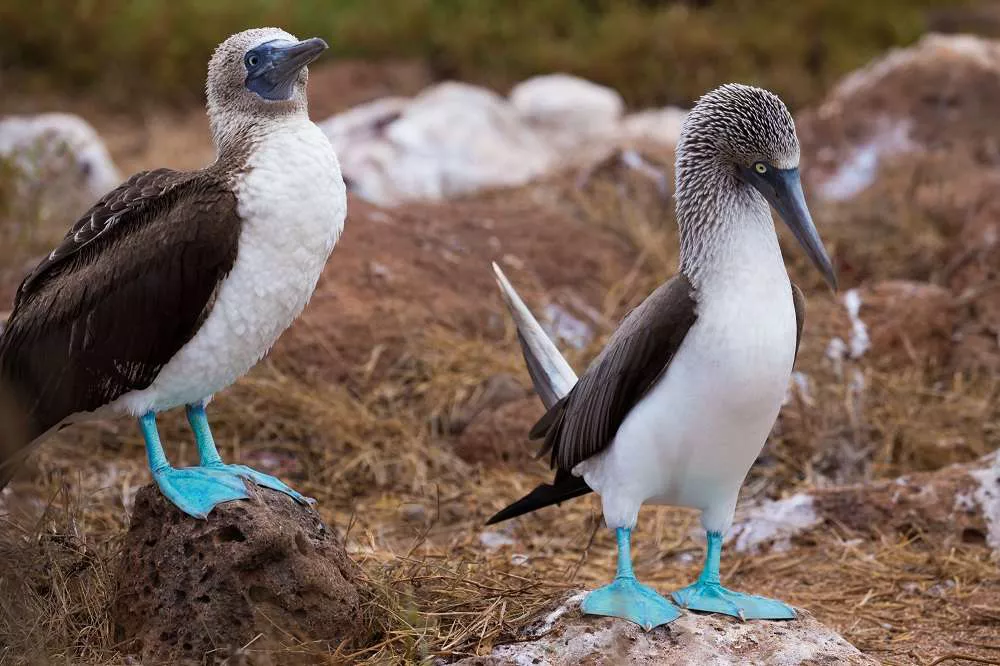The blue-footed booby is one of the most fascinating birds in the world. Its vibrant blue feet, unique behavior, and impressive flying skills make it a standout species. But where do these remarkable birds live? Understanding their habitat is key to appreciating their lifestyle and behaviors. The blue-footed booby is found in specific areas around the world, primarily in the Pacific Ocean. They are famous for living in tropical and subtropical regions, particularly on isolated islands. In this article, we will explore the habitats of the blue-footed booby, the environmental conditions they thrive in, and the places where you can find them today.
What is the Blue-Footed Booby?
Before diving into where the blue-footed booby lives, it’s important to understand what this bird is. The blue-footed booby (Sula nebouxii) is a seabird belonging to the booby family. These birds are easily recognizable due to their striking blue feet, which are used in mating displays to attract a mate. They are medium-sized birds, with a long, pointed beak and large, powerful wings. They are also known for their excellent diving skills, which they use to catch fish from the ocean.
The blue-footed booby’s name comes from the Spanish word “bobo,” which means “fool” or “clown.” This refers to the bird’s somewhat clumsy walking behavior, which is exaggerated by its large feet. Despite the humorous name, the blue-footed booby is a highly skilled and adaptive bird.
Habitat of the Blue-Footed Booby
The blue-footed booby lives in several areas of the Pacific Ocean, particularly along the coasts of Central and South America. They thrive in coastal regions with easy access to fish, which is a vital part of their diet. They prefer rocky shorelines, cliffs, and islands, where they can build their nests and find food. The blue-footed booby is also known to nest on sandy beaches and volcanic islands, which provide a safe and stable environment for their eggs.
These birds are highly migratory, so their exact location can vary depending on the time of year. They tend to stay in warm climates and avoid areas with cold water. This is because cold temperatures can affect the availability of food, which is crucial for their survival. In fact, the blue-footed booby is more commonly found in areas where the water temperature is between 20°C and 30°C.
Geographic Range of the Blue-Footed Booby
The blue-footed booby’s primary range includes the Galápagos Islands, which are located off the coast of Ecuador. This is perhaps the most famous location where blue-footed boobies are found. The islands are known for their rich biodiversity and are a major attraction for tourists who want to see these unique birds up close.
In addition to the Galápagos Islands, blue-footed boobies also inhabit the western coast of Central America, including parts of Mexico, Costa Rica, and Panama. They can also be found along the coastlines of Peru and northern Chile. These birds are not typically found in the Caribbean or the eastern Pacific, as their preferred breeding grounds are situated further west.
The birds are often seen along the coasts of Baja California in Mexico, particularly in the winter months. They migrate seasonally, following the movement of fish populations. During this time, they can be found along the shores of the Gulf of California.
Key Habitats for Blue-Footed Boobies
The Galápagos Islands
The Galápagos Islands are the most iconic and well-known home of the blue-footed booby. These volcanic islands are located in the Pacific Ocean, about 600 miles west of Ecuador. The Galápagos offer an ideal environment for blue-footed boobies due to their warm temperatures, abundant fish populations, and isolated location. The birds nest on the rocky shores of the islands, where they can find food in the surrounding waters.
The Galápagos Islands are also famous for their rich diversity of wildlife. In addition to blue-footed boobies, you can find a variety of other birds, reptiles, and marine animals. The unique ecosystems of the islands make them an important location for scientific research, conservation efforts, and eco-tourism. Visitors to the Galápagos often have the opportunity to see blue-footed boobies performing their fascinating mating rituals, which involve raising their bright blue feet as a display to attract mates.
Baja California and the Gulf of California
Baja California, located on the western coast of Mexico, is another important habitat for the blue-footed booby. The Gulf of California, which lies between Baja California and mainland Mexico, provides rich feeding grounds for the birds. The warm waters of the gulf are teeming with fish, making it an ideal location for blue-footed boobies to hunt and breed.
During the winter months, blue-footed boobies often migrate to this region in search of food. The coastlines of Baja California, with their rugged cliffs and rocky shorelines, offer suitable nesting sites for the birds. The Gulf of California also offers a safe environment for the birds to raise their chicks, as the waters are calm and nutrient-rich.
Coastal Regions of Central and South America
Blue-footed boobies are also found along the western coasts of Central and South America. Countries like Costa Rica, Panama, Ecuador, and Peru offer ideal habitats for these birds. The warm waters of the Pacific Ocean provide an abundance of fish for the booby’s diet, while the coastal cliffs and islands offer safe nesting sites.
The coastlines of Peru and northern Chile are known for their large populations of blue-footed boobies. These regions are not as well known as the Galápagos, but they are equally important for the birds’ survival. In these areas, blue-footed boobies can be seen diving for fish and performing courtship displays on the rocky shorelines.
The Importance of the Environment for the Blue-Footed Booby
The environment plays a crucial role in the survival of the blue-footed booby. These birds rely on a combination of factors to thrive, including the availability of fish, suitable nesting sites, and a warm climate. The blue-footed booby is highly adapted to life in coastal regions, and its presence is often an indicator of the health of the local marine ecosystem.
Fish Availability
One of the key factors that influence the distribution of the blue-footed booby is the availability of fish. Blue-footed boobies primarily feed on small fish, such as anchovies, sardines, and other schools of baitfish. They catch their prey by diving into the water from great heights, using their excellent swimming and diving skills. These birds need abundant fish populations to survive, which is why they are found in areas with rich marine life.
The health of fish populations is closely linked to the condition of the ocean, so any changes in water temperature or pollution can impact the availability of food for the blue-footed booby. Climate change and overfishing are major threats to marine ecosystems, which in turn threaten the survival of species like the blue-footed booby.
Nesting Sites
Another important factor for blue-footed boobies is the availability of safe nesting sites. These birds prefer nesting on rocky cliffs and isolated islands, where they can avoid predators. The islands they choose for nesting are often free from large mammalian predators, such as rats and cats, which can threaten eggs and chicks.
Some blue-footed boobies also nest on sandy beaches, though these sites are often more exposed to predators. The nests are typically simple, made of rocks or twigs, and are often situated on high ground to avoid flooding during the rainy season. The availability of suitable nesting sites is critical for the survival of the species, as it ensures that eggs and chicks are protected from harm.
Climate
The climate of the blue-footed booby’s habitat is another important factor. These birds thrive in tropical and subtropical climates, where the temperatures are warm and the seas are calm. Cold waters can reduce the availability of fish and make it harder for blue-footed boobies to find food. For this reason, they prefer regions with water temperatures between 20°C and 30°C.
The warm climate of the Galápagos Islands, Baja California, and other parts of Central and South America provides the ideal environment for the blue-footed booby. These regions offer the birds the right conditions to breed, feed, and raise their young.
Conservation and Threats to the Blue-Footed Booby
Although the blue-footed booby is not currently considered endangered, it faces several threats to its habitat. Climate change, pollution, and overfishing are all significant concerns that could affect the availability of food and suitable nesting sites. Conservation efforts are underway in many regions to protect the birds’ habitats and ensure their survival.
In the Galápagos Islands, for example, strict regulations are in place to protect wildlife and limit human impact on the environment. These efforts are vital in ensuring that the blue-footed booby continues to thrive in its natural habitat.
Conclusion
The blue-footed booby is a remarkable bird with a unique lifestyle and fascinating behavior. It lives in coastal and island environments along the Pacific Ocean, primarily in the Galápagos Islands, Baja California, and parts of Central and South America. These birds thrive in warm, tropical climates with abundant fish populations and safe nesting sites. While they are not currently at risk of extinction, the blue-footed booby faces several environmental threats, and conservation efforts are necessary to ensure its continued survival.


 Facebook
Facebook  Instagram
Instagram  Youtube
Youtube 